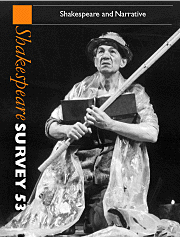Book contents
- Frontmatter
- Shakespeare’s Narremes
- Stepping Out of Narrative Line: A Bit of Word, and Horse, Play in Venus and Adonis
- A ‘consummation devoutly to be wished’: The Erotics of Narration in Venus and Adonis
- Echoes Inhabit a Garden: The Narratives of Romeo and Juliet
- A Midsummer Night’s Dream: Comedy as Apotrope of Myth
- Plutarch, Insurrection, and Dearth in Coriolanus
- Shakespeare, Crossing the Rubicon
- Vernacular Criticism and the Scenes Shakespeare Never Wrote
- The Shadow of Lear’s ‘Houseless’ in Dickens
- Shakespearian Margins in George Eliot’s ‘working-day world’
- In Her Father’s Library: Margaret Fuller and the Making of the American Miranda
- The Magician in Love
- Narrative Approaches to Shakespeare: Active Storytelling in Schools
- Monsters, Magicians, Movies: The Tempest and the Final Frontier
- Shakespeare’s Self-Repetitions and King John
- Inside Othello
- The View of London from the North and the Playhouses in Holywell
- Measured Endings: How Productions from 1720 to 1929 Close Shakespeare’s Open Silences in Measure for Measure
- Shakespearian Utopias
- Shakespeare Performances in England, 1999
- Professional Shakespeare Productions in the British Isles January–December 1998
- The Year's Contributions to Shakespearian Study 1 Critical Studies
- 2 Shakespeare’s Life, Times, and Stage
- 3 Editions and Textual Studies
- Books Received
- Index
Shakespeare’s Self-Repetitions and King John
Published online by Cambridge University Press: 28 March 2007
- Frontmatter
- Shakespeare’s Narremes
- Stepping Out of Narrative Line: A Bit of Word, and Horse, Play in Venus and Adonis
- A ‘consummation devoutly to be wished’: The Erotics of Narration in Venus and Adonis
- Echoes Inhabit a Garden: The Narratives of Romeo and Juliet
- A Midsummer Night’s Dream: Comedy as Apotrope of Myth
- Plutarch, Insurrection, and Dearth in Coriolanus
- Shakespeare, Crossing the Rubicon
- Vernacular Criticism and the Scenes Shakespeare Never Wrote
- The Shadow of Lear’s ‘Houseless’ in Dickens
- Shakespearian Margins in George Eliot’s ‘working-day world’
- In Her Father’s Library: Margaret Fuller and the Making of the American Miranda
- The Magician in Love
- Narrative Approaches to Shakespeare: Active Storytelling in Schools
- Monsters, Magicians, Movies: The Tempest and the Final Frontier
- Shakespeare’s Self-Repetitions and King John
- Inside Othello
- The View of London from the North and the Playhouses in Holywell
- Measured Endings: How Productions from 1720 to 1929 Close Shakespeare’s Open Silences in Measure for Measure
- Shakespearian Utopias
- Shakespeare Performances in England, 1999
- Professional Shakespeare Productions in the British Isles January–December 1998
- The Year's Contributions to Shakespearian Study 1 Critical Studies
- 2 Shakespeare’s Life, Times, and Stage
- 3 Editions and Textual Studies
- Books Received
- Index
Summary
Shakespeare's habit of recycling his favourite dramatic devices is generally recognized. Just about every component part of a play might be repeated - characters, episodes, 'scenic form', stage actions, thematic preoccupations, words and phrases, image clusters, and so on. How could it be otherwise? We are aware of similar self-repetition in other writers, and in composers, painters, choreographers, and think nothing of it. I want to suggest that such selfrepetitions, when of sufficient quality and quantity, can serve as an authorial finger-print, with interesting applications in other fields.
For reasons that will soon be obvious, I shall focus on self-repetitions in King John. All are found in plays that preceded King John and most of them in others that came later, though I am chiefly concerned with those that preceded. King John, in short, is never the beginning of a series of self-repetitions in the list that follows, and usually is not the end.
(1) The most striking series involves character stereotypes. For example, scolding, aggressive and bitter women revile their enemies and/or utter long-winded lamentations (Joan of Arc in 1 Henry VI; Duchess of Gloucester, Queen Elizabeth, Duchess of York in 2 and 3 Henry VI, Richard III: compare Queen Eleanor and Constance in King John). This stereotype survives, in modified form, in Lady Macbeth, Cleopatra, Volumnia, Paulina. Prattling, pathetic boys are threatened with death (Rutland in 3 Henry VI; the princes killed in the Tower, Richard III; Maduff's son, Macbeth: compare Arthur).
- Type
- Chapter
- Information
- Shakespeare SurveyAn Annual Survey of Shakespeare Studies and Production, pp. 175 - 183Publisher: Cambridge University PressPrint publication year: 2000
- 1
- Cited by

